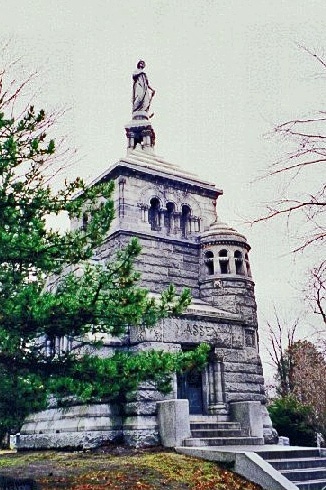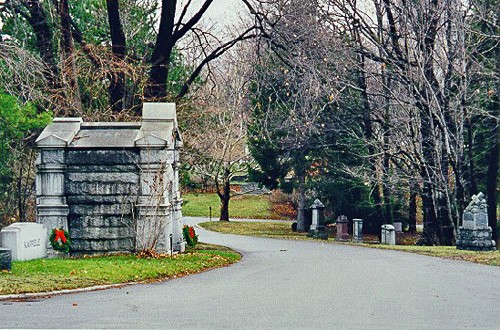Mount Pleasant Cemetery National Historic Site of Canada
The Mount Pleasant Cemetery was designated a national historic site in 2000.
Commemorative plaque: 375 Mount Pleasant Road, Toronto, Ontario Footnote 1
Designed by Henry Adolph Engelhardt and officially opened in 1876, this cemetery is an outstanding example of landscape design inspired by the European and American garden cemeteries of the 19th century. The gentle rolling terrain creates a picturesque ambiance enhanced by winding paths and roads, a variety of trees, ornamental flowers, and panoramic views. Impressive monuments and mausoleums stand testament to prominent individuals associated with local, provincial, and national history. To walk through this place of quiet contemplation is to appreciate how this cultural treasure developed over time.
Description of historic place
Mount Pleasant Cemetery National Historic Site of Canada is located in the middle of the city of Toronto, Ontario where it occupies some 83 hectares. Established in the late 19th century in an area which, at that time, was on the northern edge of urban settlement, the cemetery was designed as an informal, naturalistic environment where lawns, shrubs and mature trees mingled with large commemorative monuments and grave markers of varying styles and sizes. Many winding paths follow the contours of the scenic, treed landscape. The park-like layout provides picturesque views, which along with selective plantings, emphasize the natural beauty of the environment. Official recognition refers to the cemetery in its defined boundaries, including landscape elements, pathways, tombstones and funerary monuments.



Heritage value
Mount Pleasant Cemetery was designated a national historic site of Canada in 2000. It is designated because: it is an outstanding surviving example of picturesque design inspired by the 19th-century tradition of rural, American cemeteries defined by winding paths and roads, irregularly shaped islets, panoramic perspectives, and monuments inserted in a naturalistic setting enriched by a wide variety of groves and trees; many of the funeral monuments testify to significant epochs in the history of Toronto, Ontario and Canada; it stands out today in Canada, for the quality and integrity of its layout, which was developed in a linear fashion from west to east and for which it is possible to follow the changes that have occurred over time.

© Albertype Company / Library and Archives Canada / PA-032110

The land now comprising Mount Pleasant Cemetery was purchased in 1873 as ravine and plateau farmland in what was then the village of Deer Park. Designed in 1874 by landscape gardener H. A. Engelhardt, Mount Pleasant Cemetery’s arrangement is closely associated with the 19th-century concept of rural cemeteries. Following three years of development the cemetery opened in 1876. Such “rural” cemeteries were intended as places not only of interment, but also of contemplation and recreation. The cemetery is now distinguished by its picturesque walkways, rare trees from around the world, co-existing native specimens, and a wealth of historic funerary monuments that are well integrated into the original design.
Source: Historic Sites and Monuments Board of Canada, Minutes, June 2000.
The National Program of Historical Commemoration relies on the participation of Canadians in the identification of places, events and persons of national historic significance. Any member of the public can nominate a topic for consideration by the Historic Sites and Monuments Board of Canada.
- Date modified :